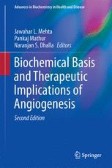Search
Search Results
-
Angiopoietins and TIE Receptors in Lymphangiogenesis and Tumor Metastasis
In contrast to the normal lymphatic network comprised of initial and collecting vessels, intratumor lymphatics are disorganized and lack vessel...
-
Oligodendrocyte precursor cell specification is regulated by bidirectional neural progenitor–endothelial cell crosstalk
Neural-derived signals are crucial regulators of CNS vascularization. However, whether the vasculature responds to these signals by means of...

-
Anti-cancer Effects of Silibinin: The Current Status in Cancer Chemoprevention
The naturally occurring flavonolignan Silibinin (also known as Silybin) is a bioactive constituent of silymarin isolated from the seeds of the milk...
-
Anti-angiogenic Targets: Angiopoietin and Angiopoietin Receptors
Tumor blood vessel formation (angiogenesis) is essential for tumor growth and metastasis. Two main endothelial ligand–receptor pathways regulating...
-
Skeletal muscle differentiation of human iPSCs meets bioengineering strategies: perspectives and challenges
Although skeletal muscle repairs itself following small injuries, genetic diseases or severe damages may hamper its ability to do so. Induced...

-
Two Diverse Hemodynamic Forces, a Mechanical Stretch and a High Wall Shear Stress, Determine Intracranial Aneurysm Formation
Intracranial aneurysm (IA) usually induced at a bifurcation site of intracranial arteries causes a lethal subarachnoid hemorrhage. Currently, IA is...

-
Significance and Molecular Regulation of Lymphangiogenesis in Cancer
Lymphatic dissemination of tumor cells involves invasion into tumor-associated lymphatic vessels, seeding of metastases in the lymph nodes, and,...
-
Impact of Docetaxel on blood-brain barrier function and formation of breast cancer brain metastases
BackgroundBreast cancer (BC) is the most frequent malignant tumor in females and the 2nd most common cause of brain metastasis (BM), that are...

-
Hypoxia-Primed Stem Cell Transplantation in Stroke
Spanning the past decade, stem cell research has made rapid progress, and stem cell transplantation in stroke has emerged as a promising treatment....
-
Sculpting the Sculptors: Methods for Studying the Fetal Cholinergic Signaling on Systems and Cellular Scales
The non-neuronal, immunological effects of the cholinergic signaling are exerted on the system’s scale of observation via the vagus nerve and on the...
-
Visualizing RNA in Live Bacterial Cells Using Fluorophore- and Quencher-Binding Aptamers
To elucidate the roles, dynamics, and regulation of RNAs, it is vital to be able to visualize the RNA of interest (ROI) in living cells...
-
Long Noncoding RNAs in Cardiovascular Disease
Recent advances in high-throughput sequencing of nucleic acids have led to the fascinating insight that the majority of the human genome is...
-
The use of the tyrosine kinase inhibitor Nilotinib in Spondyloarthritis: does targeting inflammatory pathways with a treatment lead to vascular toxicity?
Spondylarthritis (SpA) is an inflammatory rheumatic disease associated with increased incidence of major adverse cardiovascular events (MACEs)....
-
In vivo induction of membrane damage by β-amyloid peptide oligomers
Exposure to the β-amyloid peptide (Aβ) is toxic to neurons and other cell types, but the mechanism(s) involved are still unresolved. Synthetic Aβ...

-
TIE
The Tie receptor tyrosine kinase (RTK) family that comprises the Tie1 and Tie2 receptors forms a distinct subfamily among the mammalian RTK families....
-
Therapeutic targeting of the angiopoietin–TIE pathway
The endothelial angiopoietin (ANG)–TIE growth factor receptor pathway regulates vascular permeability and pathological vascular remodelling during...

-
Capillary K+-sensing initiates retrograde hyperpolarization to increase local cerebral blood flow
Blood flow into the brain is dynamically regulated to satisfy the changing metabolic requirements of neurons, but how this is accomplished has...

-
Disrupting Tumor Angiogenesis and “the Hunger Games” for Breast Cancer
Angiogenesis, one of the hallmarks of cancers, has become an attractive target for cancer therapy since decades ago. It is broadly thought that...
-
Vascular Stem Cells in Regulation of Angiogenesis
Angiogenesis is the process by which new vessels are generated from the preexisting blood vessels, which is the major contributor of postnatal...
